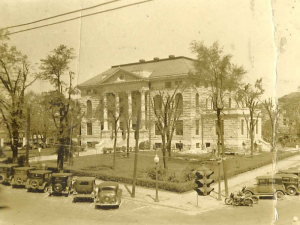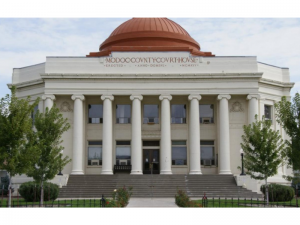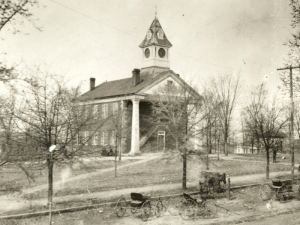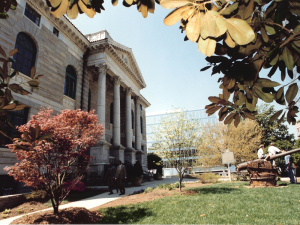Ode to a Granite Place: 200 Years of History at the Historic DeKalb Courthouse
Looking back at 200 years of courthouse history in DeKalb County.
By J Blomqvist
I get it. The words “DeKalb County Courthouse” (more specifically, styled as DeKalb Covnty Covrt Hovse) are chiseled on the building. People visit us regularly, looking for Judge so-and-so’s office or to ask if this is the place to get a passport or a gun permit. I get it – “courthouse” on the building means court business inside. We’ve put signs on the doors, in the lobby, and on places around the outside of the building to help visitors navigate, but to no avail. I suppose when you’re thinking about your appointment with a judge or your need for a passport, you’re not paying attention to the signs that say “DeKalb History Center.” The engraving on the building is permanent and directs people here for court business. I get it. This building became too small to hold DeKalb’s court business in the early 1960s and a new nine-story courthouse was built just across the square from here. In the excerpts below, from Franklin Garrett’s Atlanta and Environs (1954) the theme of outgrowing has been a constant since the courthouse’s inception.
“DeKalb County outgrew its original log courthouse in less than seven years. So, in 1829, a neat brick building was erected in the center of the present Square at the cost of $5,100. It was completed by George Tomlinson, the contractor, and accepted by the Inferior Court on April 21. During the month of March, James Lemon had been paid $10 with which to purchase materials for glazing the courthouse and Thomas Ray $15 for making steps to the door. Thirteen years later the neat brick building of 1829 was to serve as an incinerator for practically all of the county records.” pg. 77 [In other words, the second courthouse burned to the ground in 1842.]
“This courthouse, signed, sealed and delivered in 1847 was to serve the County of De Kalb for 51 years. Finally outgrown and outmoded, it was laboriously torn down in 1898 to make way for a larger building…” pgs. 244-245
There are no photos of the first two courthouses.
Third courthouse, 1847 – 1898.
The 1847 Greek Revival courthouse was a fairly plain two-story red brick building. By the 1890’s DeKalb Counties population (over 20,000) had outgrown the brick Courthouse, and a new building was needed.
Tearing down the Greek Revival building was no easy task. From the Atlanta Constitution, April 14 1898. “The attempt to blow up the DeKalb courthouse at Decatur was not successful and the only result was to waste a quantity of dynamite and afford a lot of amusement for the citizens of Decatur.”
It was finally decided to tear down the building by brute force. From the Atlanta Constitution, “Some bright spirit suggested that the best way was to knock it down with rocks.” After the walls unsuccessfully from the bombardment of rocks, it was then decided to shoot the walls with muskets.
The walls did not crumble. Finally, a metal bar with a rope was affixed to an open window and the crowed tugged until it fell.
DeKalb began work in 1898 on a new granite courthouse, equipped with a special room for women, complete with toilets. Walls were constructed of two layers of bricks made in Decatur and covered with granite from Lithonia. The cost was $60,000.
“The cornerstone of the new courthouse was laid on November 24, 1898, with impressive Masonic ceremonies.
Fourth courthouse, 1898 – 1916.
The new building, completed during the following year, served its purpose adequately until mid-September 1916, when it was gutted by a blaze of undetermined origin.” pg. 349
The firm of Walker & Chase, Architects, were hired to supervise the rebuilding, and Donaldson & Pearson were the General Contractors. The east and west porticos were removed and one-story wings added for offices; the eastern wing had a separate entrance, and the western wing housed county records. The cupola was not rebuilt after the fire, but two of the clocks were placed in the remaining porticoes.

Fifth courthouse, 1918 – 1967.
The needs of DeKalb County county continued to outgrow the building. In 1935, a third ½ story was added to the main building. In 1950, a second story was added to the east and west wings to serve as additional court and jury rooms; this addition can be easily discerned, because the veining of the granite is different.
This courthouse was used by DeKalb County until 1967, when the county built a new courthouse.
Historic DeKalb Courthouse, 1968 – present.
We’ve also had visitors ask us about the use of “v” as “u” in the etching and in the plaque pictured below. Many buildings from the late 1800s to the early 1900s featured classical architectural details, from the Roman columns to the letters etched on the building. This is because the Classical Latin or Roman alphabet had only 23 letters, not the 26 that we have today. If used as a vowel, V was pronounced /ū/ as in “smooth” but V could also be a consonant pronounced /ww/ as in “wood.” This is why a “W” looks the way it does; it is a double “V.” Get it? Double “U.” The phrase Vedi, Vidi, Vici in Classical Latin was pronounced “wedi, widi, wici.”
Then U, as a letter, began to show up in the 1600s with the standardization of printing.
Etching the words as “DeKalb Covnty Covrt Hovse” was a stylistic choice, not a typo.

Plaque located inside the Historic DeKalb Courthouse.
Other examples of courthouses with the “v” style etching:

Union County Courthouse, South Carolina.

Modoc County Courthouse, California.
We will forever be answering questions about where the courthouse is, as we sit here in the busy Decatur square. We hope people remember to come and visit the DeKalb History Center as they finish up their important court business!









